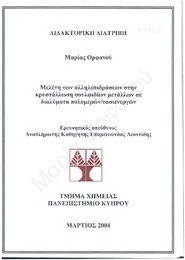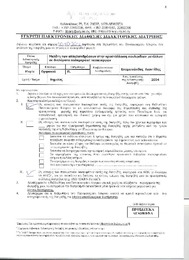| dc.contributor.advisor | Λεοντίδης, Επαμεινώνδας | el |
| dc.contributor.author | Ορφανού, Μαρία | el |
| dc.coverage.spatial | Κύπρος | el |
| dc.coverage.spatial | Cyprus | en |
| dc.creator | Ορφανού, Μαρία | el |
| dc.date.accessioned | 2012-09-21T07:35:46Z | |
| dc.date.accessioned | 2017-08-03T10:41:31Z | |
| dc.date.available | 2012-09-21T07:35:46Z | |
| dc.date.available | 2017-08-03T10:41:31Z | |
| dc.date.issued | 2003 | |
| dc.date.submitted | 2003 | |
| dc.identifier.uri | https://gnosis.library.ucy.ac.cy/handle/7/39493 | en |
| dc.description | Διατριβή (Διδακτορική) -- Πανεπιστήμιο Κύπρου, Σχολή Θετικών και Εφαρμοσμένων Επιστημών, Τμήμα Χημείας, 2004. | el |
| dc.description | Η βιβλιοθήκη διαθέτει αντίτυπο της διατριβής σε έντυπη μορφή. | el |
| dc.description.abstract | Σε αυτή την διατριβή μελετήθηκε η κρυστάλλωση των σουλφιδίων του μολύβδου, χαλκού, καδμίου, κοβαλτίου και νικελίου σε αραιά διαλύματα πολυμερών και τασιενεργών. Χρησιμοποιήθηκαν μόνο μη ιοντικά πολυμερή, ενώ σαν τασιενεργά χρησιμοποιήθηκαν κυρίως το δωδεκυλοθειικό νάτριο (SDS) και λιγότερο το τετραδεκυλοθειικό νάτριο (SMS) και το δωδεκανοϊκό νάτριο (SDoD). Στα διαλύματα όπου λαμβάνει χώρα η κρυστάλλωση συνυπάρχουν διαφόρων τύπων αλληλεπιδράσεις μεταξύ των συστατικών. Η πιο σημαντική είναι η αλληλεπίδραση μεταξύ των μεταλλοκατιόντων και των τασιενεργών, η οποία σχετίζεται άμεσα με την θερμοκρασία αύξησης διαλυτότητας (θερμοκρασία Krafft) των τασιενεργών και το γινόμενο διαλυτότητας μετάλλου-τασιενεργού. Επίσης σημαντική είναι η αλληλεπίδραση μεταξύ πολυμερών και τασιενεργών μορίων. Σε κάποιες περιπτώσεις παίζει ρόλο η αλληλεπίδραση μεταξύ των πολυμερικών μορίων και των μεταλλοϊόντων, ενώ εκείνη μεταξύ των μακρομορίων και των σχηματιζόμενων κολλοειδών σωματιδίων παίζει βασικό ρόλο στη σταθεροποίηση της διασποράς. Η επίδραση όλων των παραπάνω αλληλεπιδράσεων στην κρυστάλλωση μελετήθηκε με την χρήση διαφορετικών μεταλλοκατιόντων, τασιενεργών μορίων και ενός αριθμού υδατοδιαλυτών πολυμερών.
Τα ανιοντικά τασιενεργά, σε συγκεκριμένες συγκεντρώσεις, αλληλεπιδρούν με τα μη ιοντικά υδρόφιλα πολυμερή σχηματίζοντας μικύλια, τα οποία προσδένονται πάνω στις πολυμερικές αλυσίδες. Σε διαλύματα με συγκεκριμένες για κάθε ζεύγος πολυμερούς-τασιενεργού συγκεντρώσεις εισάγονται μετέπειτα τα ιόντα μετάλλων και θείου και παρακολουθείται η χρονική εξέλιξη της κρυστάλλωσης των σωματιδίων με ηλεκτρονική μικροσκοπία και περίθλαση ακτίνων Χ. Η σταθεροποίηση των σωματιδίων του διαλύματος είναι εφικτή από την παρουσία των τασιενεργών και των μακρομορίων.
Από τη μελέτη της κρυστάλλωσης θειούχου μολύβδου σε διαλύματα πολυμερούς/SDS παρατηρήθηκε ότι το τασιενεργό παρεμβαίνει στην κρυστάλλωση του θειούχου μολύβδου και ότι υπάρχει χρονική εξέλιξη στις μορφολογίες των παραγομένων προϊόντων. Αρχικά σχηματίζονται στο διάλυμα φυλλώδεις δομές του αδιάλυτου δωδεκυλοθειικού μολύβδου (Pb(DS)2) και σφαιροειδή σωματίδια σύνθετης μορφολογίας. Η επιφάνεια και το εσωτερικό των σφαιρικών σωματιδίων αποτελείται από νανοσωλήνες με πολυστρωματικά τοιχώματα και από νανοφυλλώσεις δομές παρόμοιες με τα τοιχώματα των νανοσωλήνων. Με ηλεκτρονικό μικροσκόπιο υψηλής διακριτικής ικανότητας αποδείχτηκε ότι τα τοιχώματα των νανοσωλήνων αποτελούνται από νανοσωματίδια θειούχου μολύβδου και στρώματα τασιενεργού. Όμως οι δομές αυτές σταδιακά εξαφανίζονται και φαίνεται ότι επικρατούν τα φύλλα του Pb(DS)2 που βρίσκονται σε αιώρηση. Αποδείχτηκε ότι η δημιουργία όλων των μορφολογιών είναι ανεξάρτητη από την ύπαρξη αλληλεπίδρασης μεταξύ των τασιενεργών μορίων και του πολυμερούς στο διάλυμα.
Η κρυστάλλωση του θειούχου χαλκού σε διαλύματα PEO/SDS δεν παρουσιάζει ανάλογη χρονική διαφοροποίηση. Μελετήθηκαν οι θερμοκρασίες κρυστάλλωσης των 30 °C και 8 °C, οι οποίες είναι αντίστοιχα πάνω και κάτω από την θερμοκρασία Krafft του δωδεκυλοθειικού χαλκού (Cu(DS)2). Στους 30 °C σταθεροποιούνται νανοσωματίδια θειούχου χαλκού και στους 8 °C σχηματίζονται μεγάλα φύλλα CU(DS)2 από την αρχή της αντίδρασης. Η μελέτη του είδους των σουλφιδίων του χαλκού με φασματοφωτομετρία UV-vis και XRD έδειξε ότι στα στερεά αιωρήματα συνυπάρχουν ο κρυσταλλικός κοβελλίτης (CuS) και ο άμορφος χαλκοσίτης (C112S) και είναι πιθανόν ο περισσότερος χαλκός του διαλύματος να είναι στην οξειδωτική κατάσταση Cu1+.
Η κρυστάλλωση θειούχου κοβαλτίου σε διαλύματα PEO/SDS στους 8 °C καταλήγει επίσης στο σχηματισμό φύλλων τασιενεργού. Στην κρυστάλλωση θειούχου νικελίου και θειούχου κοβαλτίου σε αυξημένες συγκεντρώσεις (> 4mM Co2+ ή Ni2+ και ολικού S(II)) σχηματίζονται αποκλειστικά δενδρίτες. Τέλος η εισαγωγή θειούχου καδμίου σε διαλύματα με πολυμερή και τασιενεργά καταλήγει στο σχηματισμό φύλλων τασιενεργού όταν υπάρχει αλληλεπίδραση Cd2+-τασιενεργού και καταβύθιση θειούχου καδμίου στην απουσία της αλληλεπίδρασης αυτής.(...) | el |
| dc.description.abstract | In this thesis the crystallization behavior of lead, copper, cadmium, cobalt and nickel sulfide was examined in dilute solutions of polymer and surfactant molecules.
Aqueous solutions of non-ionic polymers with the anionic surfactant sodium dodecyl sulfate (SDS). were used. The surfactants sodium tetradecyl sulfate (SMS) and sodium dodecanoate (SDoD) were also used in some experiments. In the polymer/surfactant/metal sulfide solutions various types of interactions exist between the components that can affect the morphology and nature of the products. The most important interaction is that between the negatively charged surfactant and metal cations, which is directly related to the surfactant solubility (Krafft temperature) and the solubility product of metal-surfactant complexes. Of equal importance is the interaction between the polymer and the surfactant molecules. In some cases the interaction between the polymer molecules and the metal ion is observed, while the interaction between the macromolecules and the colloid particles is essential for the stabilization of the dispersion. All of the above interactions were studied with the use of different metal ions, different surfactant molecules and a number of water-soluble polymers.
In a concentration regime specific for every surfactant and polymer pair, the surfactant molecules interact with the non-ionic polymers, forming complexes that are surfactant micelles attached to the polymer chains. In this thesis metal and sulfide ions are added in polymer and surfactant solutions within this concentration regime and their crystallization is monitored with electronic microscopy and x-ray diffraction.
When lead sulfide crystallizes in polymer/SDS solutions the surfactant molecules interfere in its crystallization process. The evolution of the structures in the crystallization solution is followed in various reaction times. At the beginning of the reaction lamellar structures of lead dodecyl sulfate (Pb(DS)2) and spherical particles of a complex morphology are formed. The surface and the interior of the spherical particles are composed of multiwalled nanotubes and nanolamellar structures with layers similar to the nanotubes walls. Using a high resolution electron microscope it was found that the walls of the nanotubes are composed of alternating layers of lead sulfide particles and surfactant molecules. These nanostructures gradually disappear and after some time the solution contains, mostly lead dodecyl sulfate crystals. It
appears that this is .the therniodynamicaHy stable product of the reaction, it was also found that the formation of these solution structures is independent of the existence of the polymer-surfactant interaction.
The study, of copper sulfide- crystallization in PEO/SDS solutions did not reveal the formation of metastable nanostructures similar to the PbS system. The crystallization temperatures of 30 °C and 8 °C were studied, which are respectively above and below the Krafft Temperature of copper dodecyl sulfate (Cu(DS)2). At the temperature of 30 °C only stabilized copper sulphide nanoparticles are being formed. At the temperature of 8 °C large organic crystals, probably Cu(DS)2, are the main product of the reaction. The type of copper sulphide of the solutions was studied with UV-vis spectrometry. It was found that covellite (CuS) and chalcosite CU2S coexist in equilibrium, and it is possible that most of the soluble copper is in the Cul+ oxidation state. (...) | en |
| dc.format.extent | 163 σ. : εικ. ; 29 εκ. + 1 CD-ROM | el |
| dc.language.iso | gre | en |
| dc.publisher | Πανεπιστήμιο Κύπρου, Σχολή Θετικών και Εφαρμοσμένων Επιστημών / University of Cyprus, Faculty of Pure and Applied Sciences | |
| dc.rights | info:eu-repo/semantics/openAccess | en |
| dc.rights | Open Access | en |
| dc.subject.lcsh | Crystalline polymers | en |
| dc.subject.lcsh | Crystallization | en |
| dc.subject.lcsh | Polymers | en |
| dc.title | Μελέτη των αλληλεπιδράσεων στην κρυστάλλωση σουλφιδίων μετάλλων σε διαλύματα πολυμερών/ τασιενεργών | el |
| dc.title.alternative | Study of the interactions on the crystallization of metal suphides in polymer/surfactant solutions | en |
| dc.type | info:eu-repo/semantics/doctoralThesis | en |
| dc.contributor.committeemember | Λεοντίδης, Επαμεινώνδας | el |
| dc.contributor.committeemember | Κουτσούκος, Πέτρος | el |
| dc.contributor.committeemember | Παναγιώτου, Κώστας | el |
| dc.contributor.committeemember | Πατρίκος, Κώστας | el |
| dc.contributor.committeemember | Πασχαλίδης, Ιωάνννης | el |
| dc.contributor.committeemember | Leontides, Epameinondas | en |
| dc.contributor.committeemember | Koutsoukos, Petros | en |
| dc.contributor.committeemember | Panayiotou, Costas | en |
| dc.contributor.committeemember | Patrikios, Costas | en |
| dc.contributor.committeemember | Paschalides, Ioannis | en |
| dc.contributor.department | Πανεπιστήμιο Κύπρου, Σχολή Θετικών και Εφαρμοσμένων Επιστημών, Τμήμα Χημείας | el |
| dc.contributor.department | University of Cyprus, Faculty of Pure and Applied Sciences, Department of Chemistry | en |
| dc.subject.uncontrolledterm | ΠΟΛΥΜΕΡΗ | el |
| dc.subject.uncontrolledterm | ΑΝΙΟΝΤΙΚΑ | el |
| dc.subject.uncontrolledterm | ΤΑΣΙΕΝΕΡΓΑ | el |
| dc.subject.uncontrolledterm | ΗΛΕΚΤΡΟΝΙΚΟ ΜΙΚΡΟΣΚΟΠΙΟ | el |
| dc.subject.uncontrolledterm | ΚΡΥΣΤΑΛΛΩΣΗ | el |
| dc.subject.uncontrolledterm | ΣΟΥΛΦΙΔΙΑ | el |
| dc.subject.uncontrolledterm | ΜΕΤΑΛΛΑ | el |
| dc.subject.uncontrolledterm | ΝΑΝΟΣΩΜΑΤΙΔΙΑ | el |
| dc.subject.uncontrolledterm | POLYMERS | en |
| dc.subject.uncontrolledterm | ANIONIC SURFACTANTS | en |
| dc.subject.uncontrolledterm | SULFIDES | en |
| dc.subject.uncontrolledterm | ELECTRONIC MICROSCOPE | en |
| dc.subject.uncontrolledterm | NANOPARTICLES | en |
| dc.subject.uncontrolledterm | CRYSTALLISATION | en |
| dc.subject.uncontrolledterm | POLYETHYLENE OXIDE | en |
| dc.subject.uncontrolledterm | COPPER SULPHIDE | en |
| dc.identifier.lc | QD382.C78O73 2004 | en |
| dc.author.faculty | Σχολή Θετικών και Εφαρμοσμένων Επιστημών / Faculty of Pure and Applied Sciences | |
| dc.author.department | Τμήμα Χημείας / Department of Chemistry | |
| dc.type.uhtype | Doctoral Thesis | en |
| dc.rights.embargodate | 2004 | |
| dc.contributor.orcid | Λεοντίδης, Επαμεινώνδας [0000-0003-4427-0398] | |


